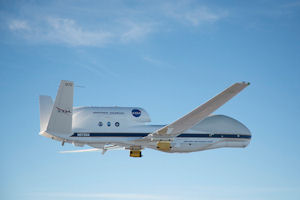Mar 13 2015
A cutting-edge science instrument developed by The University of Manchester researchers took to the skies aboard NASA’s Global Hawk research aircraft for the first time.
 Global Hawk aircraft
Global Hawk aircraft
The unmanned aircraft, based at NASA’s Armstrong Flight Research Centre, California, can fly at twice the height of Mount Everest and double the altitude of a commercial jet for more than a day at a time, travelling the equivalent of half of the Earth’s circumference in a single flight in an atmosphere where the air pressure is less than a tenth of that at sea level.
The aircraft is flying above the equatorial regions of the Pacific Ocean at an altitude of 20km, where the lowest layer of the atmosphere, the troposphere, meets the stratosphere above. Scientists believe this area, known as the tropopause, plays a critical role in Earth’s climate.
One of the instruments onboard, AIITS (the Aerosol Ice Interface Transition Spectrometer), measures particles like dust, water droplets, and ice crystals. The transport of particles and pollutants between the troposphere and stratosphere plays a crucial role in the climate system and the health of the ozone layer. AIITS was jointly developed by the universities of Hertfordshire and Manchester.
AIITS is able to detect and measure the scattering and surface properties in great detail of single ice crystals in these clouds including as they evolve from the possible amorphous phases to the ice phase. These fundamental measurements, combined with the Global Hawk's other state of the art equipment will be used to improve weather models.
Professor Martin Gallagher and Dr James Dorsey of The University of Manchester helped to develop the instrument.
Martin said: “Cirrus clouds typically cover 30% of the globe and are a critical component of global climate models since depending on their altitude, thickness, ice particle size and shape, they can either cool or warm the upper atmosphere. However cirrus radiative properties in the infra-red, where they may contribute significantly to the Earth's long-wave radiation budget have not been comprehensively measured together with in situ microphysics and state properties of this part of the atmosphere.”
James, of The National Centre for Atmospheric Science at The University of Manchester said: “This is an incredible opportunity to bring together the University of Hertfordshire's technical experience and Manchester's atmospheric measurement expertise with a uniquely capable aircraft. The ability to make measurements up to the equatorial stratosphere means that we can address important questions about the global water cycle and its role in Earth's climate. And flying to the Galapagos Islands and back non-stop makes for a really interesting day at the office.”